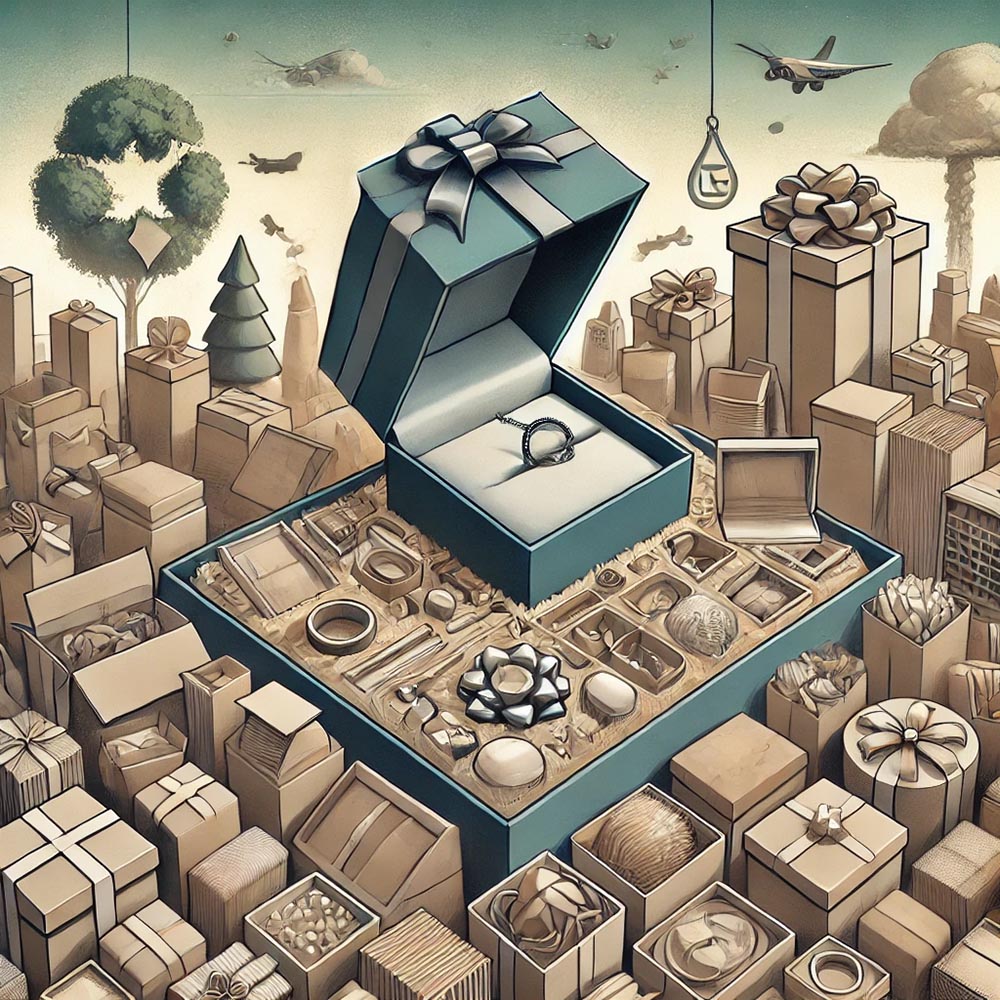The Paradox of Packaging: Insights from a Factory Worker
As an employee at a drawstring bag factory, I spend my days moving between the workshop, warehouse, and office. The sounds of packing tape being pulled, cardboard boxes rubbing against each other, and printers churning out labels have become my most familiar background noise. While organizing warehouse photos recently, I stumbled upon an interesting discovery: the packaging volume for the same drawstring bag specifications has shrunk by one-third compared to three years ago. This got me thinking—are we being "held hostage" by packaging?
Sales Packaging: When "Presentation" Becomes a Burden
Packaging That Collects Dust
Last Christmas, a European client requested double-layer hot-stamped gift boxes for our drawstring bags. Watching workers pack a $1.50 bag into a $4.00 box on the production line, I suddenly recalled 500 faux leather gift boxes collecting dust in the warehouse—remnants of an order canceled six months ago.
Many industries have fallen into a "packaging arms race":
Excessive printing: To highlight a "premium feel," bags undergo multi-layer printing, with matte lamination and spot UV coating added to the outer box.
Nesting packaging: A single bag often comes with a non-woven dust bag, tissue paper, rigid cardboard, and plastic wrapping.
Unnecessary accessories: Thank-you cards, care manuals, and desiccant packets are frequently discarded immediately.
Ironically, when we introduced a "bare packaging" option—simply wrapping the bag in recycled paper for dust protection—the repurchase rate among Nordic customers increased by 12%. This aligns with an industry statistic I once heard: 72% of European consumers are willing to pay higher shipping fees for simplified packaging.
The Cost of Visual Illusions
A well-known personal care brand faced backlash for its travel kit, which included:
30ml shampoo (actual value: €0.80)
Embossed glass bottle (costing three times more than the product inside)
Magnetic closure gift box (requiring specialized recycling equipment)
Three-language instruction manual (92% of customers simply scan the QR code for details)
Such "packaging inflation" is even more insidious in the food industry. One cereal brand enlarged its box by 15% while reducing the product inside by 10%, using air pockets to create an illusion of abundance.
Industry Data Insights:
Packaging costs for trial-size personal care products account for 67% of the total cost (Source: Smithers 2024 Report).
Shrink-wrapped promotional bottled water contains more plastic in its wrapping than in the bottles themselves.
27% of e-commerce returns are due to products being damaged in transit because of excessive but ineffective packaging.
Transport Packaging: The Misunderstood "Sense of Security"
Overpacking Driven by Misconceptions
After witnessing warehouse staff pack drawstring bags into five-layer corrugated boxes, I finally understood the frustration of receiving a tiny clothing order in a refrigerator-sized box. Overpacking often stems from three common misconceptions:
Misunderstanding material strength:
Tests show that 1.2cm-thick pearl cotton can withstand 200kg of static pressure, yet people often assume "filling every gap" is the only way to ensure safety. Our packaging simulation tests revealed that reducing filler by 30% increased damage rates by only 0.7%.
Lack of standardization:
An American client insisted that each carton contain exactly 53 bags—solely because their warehouse shelves were 1.35 meters high. When we suggested a standard 50 bags per box, it lowered custom box costs and improved restocking efficiency by 20%.
Excessive sealing habits:
Pallets wrapped like mummies, cartons sealed with multiple layers of tape—these "security performances" only make unpacking harder. Switching to H-pattern taping + corner protectors + biodegradable strapping actually reduced customer complaints.
The Absurd Journey of a Homeware Brand
Tracking a homeware brand's global shipping route exposed some absurd realities:
China factory: Ceramic mugs packed with honeycomb cardboard.
Transit warehouse: Five additional layers of bubble wrap.
European distribution center: Wooden crates and waterproof bag sealing.
By the time the product reached consumers, its packaging weight was four times its own weight—each stage compensating for previous inefficiencies.
Industry Contradictions:
61% of glassware shipping damage is caused by vibration, not insufficient padding (Source: TT Club Maritime Data).
Cold chain packaging beyond 6cm EPS thickness offers diminishing insulation benefits.
2023 global cross-border parcel shipments had an average void fill rate of 37%, equivalent to shipping 240 million cubic meters of air annually. (Source: World Shipping Council)
Bulk Packaging: The Hidden Costs No One Talks About
Bulk Packaging "Insurance Thinking"
To prevent moisture damage in ocean shipping, a desiccant packet is double-wrapped in an aluminum foil pouch.
To prevent label loss, each box has three redundant stickers.
Cartons designed for max weight capacity often remain half-empty during shipping.
Excess Packaging Waste in Overstock Handling
A batch of 300 defective products could have been repackaged in a simpler format. Instead, to "maintain brand consistency," they were fully repacked—only to be sold at a clearance price that couldn't even recover packaging costs.
Systemic Resource Drain
A multinational retailer exposed hidden losses during clearance sales:
Near-expiry vitamins were destroyed due to mismatched packaging batch numbers.
Individually wrapped tea bags had 2.1 times more aluminum foil weight than tea leaves.
Seasonal product packaging molds were discarded after only 96 hours of use.
Supply Chain Gaps:
Stationery sets use oversized plastic inserts to create an illusion of value.
Cross-border book shipments force redundant promotional flyers into every box.
The same product is repackaged differently to manipulate pricing across sales channels.
Returning to the Core: What Drawstring Bags Taught Me
While chatting with an experienced worker, he pointed at the automated packaging line and said:
"Today's machines are twice as fast as three years ago, but we've added three more packaging steps instead."
That hit me hard. We produce lightweight, eco-friendly drawstring bags, yet excessive packaging contradicts their very essence.
Perhaps the real packaging revolution isn't about adding more layers of protection—it's about learning from drawstring bags themselves:
Securely tightened when necessary, ensuring protection.
Loosened when possible, reducing unnecessary burden.




 We like to do design according to all the customers' requirements, or offer them our new designs. With strong OEM/ODM capabilities, we can fill your sourcing demands.
We like to do design according to all the customers' requirements, or offer them our new designs. With strong OEM/ODM capabilities, we can fill your sourcing demands.